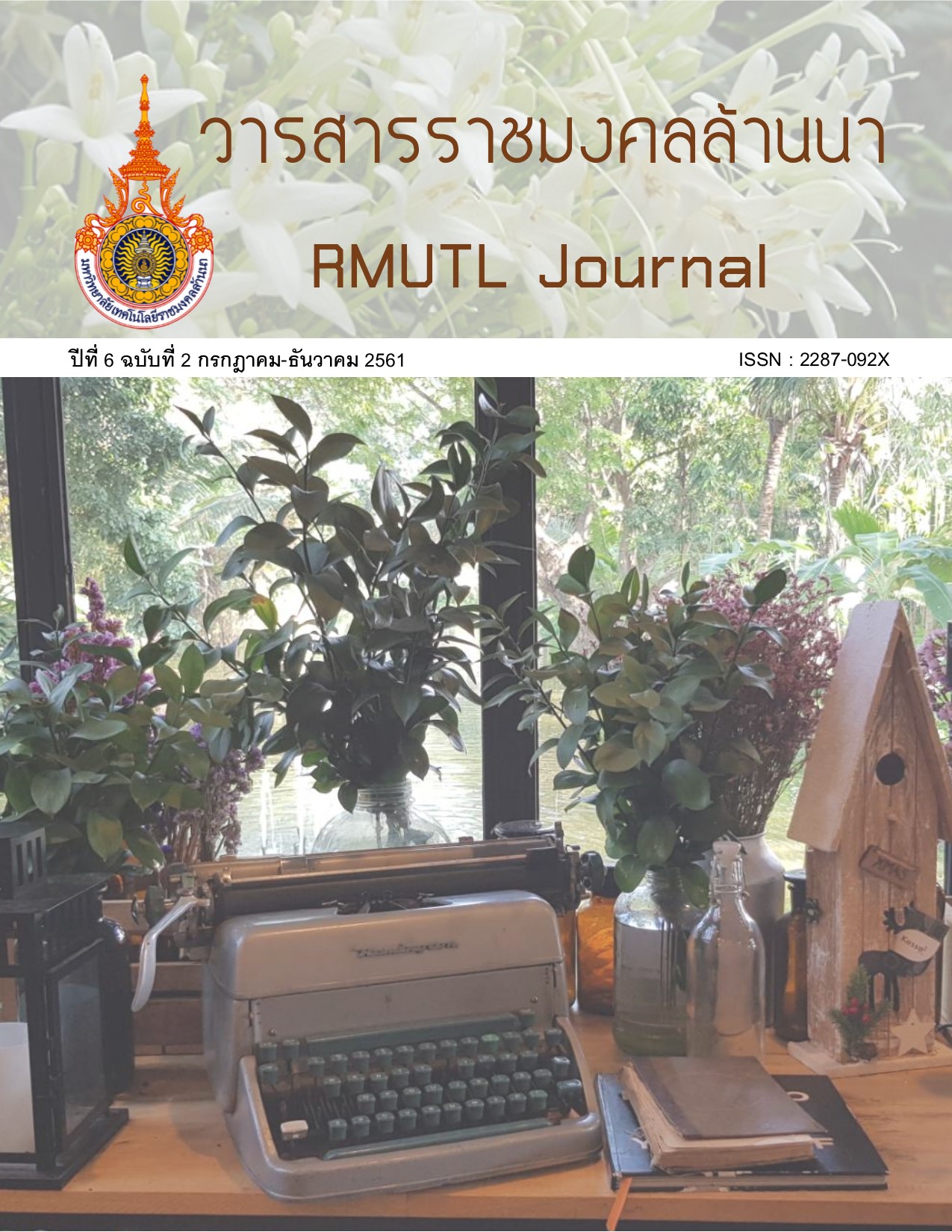The Study of Factors promoting quality life of elders in Chiang Mai Province
Main Article Content
Abstract
This study had the purpose to study factors that enhance good quality of life for the elders. The samples in this study is the elders in Chiang Mai. The size of the sample was determined by the Cochran formula in case of unknown size of population. Estimated proportion of interest in population is 0.5 of the desired population size. The sample size was set to at least 384 people. The researcher increased the number to 3 percent to prevent data discrepancies. Thus, data were collected from 396 samples. Multi-stage sampling was used. First, random cluster sampling was used to divide the area into 25 sub-districts in Chiang Mai After that, collecting data by specific selection and the sample was aged 60 years or older and had good quality of life evaluate by WHO Quality of Life-Brief-Thai. The instrument used for this study was the questionnaires with 5-scale of rating scales. It contained with elders in 4 contents such as Health, Family, Social-welfare, and Economic. Content validity was verified by 3 experts. The reliability of Cronbach's alpha of each scales were found between .72 and .85 and the total reliability was .87. The data were analyzed using descriptive statistics and inferential statistics, such as t-test for two independent sample groups and one-way ANOVA.
The study indicated that the general information of respondents were the elders 396 persons, married, lived with their spouses with no children living with them, and used social-welfare for medical treatment. The factors contributing to good quality of life in health, family, public welfare and economic of the elders in Chiang Mai had conclusion as follows: 1) The gender differences had no effect on quality of life in health, family, public welfare and economy. 2) The different of ages had affecting quality of life in health, family, public welfare and economic aspects significantly at 0.5 3) Different economic status affecting quality of life in health, family, public welfare and economy by significantly at .05 and 4) Different exercise habits influence of quality of life on health at .05 level of significant.
Article Details
บทความวิจัยนี้เป็นของลิขสิทธิ์
References
ขวัญสุดา บุญทศ และขนิษฐา นันทบุตร. (2560). ความสุข ความทุกข์ และสุขภาพจิตผู้สูงอายุในชุมชนแห่งหนึ่งในภาคเหนือตอนบน ประเทศไทย. วารสารสมาคมจิตแพทย์แห่งประเทศไทย., 62(3): 257-270.
จิตนภา ฉิมจนดา. (2555). ปัจจัยที่มีอิทธิพลต่อความสุขในชีวิตของผู้สูงอายุในชุมชน จังหวัดนครปฐม. พยาบาล ศาสตรมหาบัณฑิต สาขาวิชาการพยาบาลเวชปฏิบัติชุมชน. มหาวิทยาลัยคริสเตียน.
เจษฎา บุญทา. (2545). คุณภาพชีวิตผู้สูงอายุในตำบลแม่หอพระ อำเภอแม่แตง จังหวัดเชียงใหม่. สาธารณสุขศาสตรมหาบัณฑิต, มหาวิทยาลัยเชียงใหม่.
ดิเรก ปัทมสิริวัฒน์. (2551). ความสามารถการออมของครัวเรือนไทยและความเหลื่อมล้ำทางเศรษฐกิจ. วารสารเศรษฐศาสตร์ศรีนครินทรวิโรฒ. 4(4): 19-49.
ประนอม โอทกานนท์. (2554). ชีวิตที่สุขสมบูรณ์ของผู้สูงอายุไทย หลักการ งานวิจัย และบทเรียนจากประสบการณ์. พิมพ์ครั้งที่ 2. กรุงเทพฯ : สำนักพิมพ์แห่งจุฬาลงกรณ์มหาวิทยาลัย.
ประภาพร จินันทุยา. (2536) คุณภาพชีวิตของผู้สูงอายุในชมรมทางสังคมผู้สูงอายุดินแดง. พยาบาลศาสตรมหาบัณฑิต สาขาวิชาพยาบาลศาสตร์, มหาวิทยาลัยมหิดล.
ปิยภรณ์ เลาหบุตร. (2557). คุณภาพชีวิตของผู้สูงอายุในชุมชนหมู่ 7 ตำบลพลูตาหลวง อำเภอสัตหีบ จังหวัดชลบุรี. รัฐประศาสนศาสตรมหาบัณฑิต สาขาวิชาการบริหารทั่วไป, มหาวิทยาลัยบูรพา.
ภาวิณี วรประดิษฐ. (2554). ผู้สูงอายุและภาวะสุขภาพผู้สูงอายุ. [ออนไลน์] ได้จาก : http://trat.nfe.go.th/ trat/topic5_old.php?page=10
มารศรี นุชแสงพลี. (2532). ปัจจัยที่มีอิทธิพลต่อความพึงพอใจของผู้สูงอายุ: ศึกษากรณีผู้สูงอายุในชุมชนบ่อนไก่กรุงเทพมหานคร. สังคมวิทยาและมานุษยวิทยามหาบัณฑิต สาขาสังคมวิทยาและมานุษยวิทยา,มหาวิทยาลัยธรรมศาสตร์.
รักษพล สนิทยา และวิราภรณ์ โพธิศิริ. (2554). ปัจจัยที่มีอิทธิพลต่อภาวะสุขภาพจิตของผู้สูงอายุในจังหวัดน่าน. การประชุมวิชาการประชากรศาสตร์แห่งชาติครั้งที่ 3 มหาวิทยาลัยมหิดล, 16 -17 กุมภาพันธ์2554., หน้า 55-63.
วรัทยา กุลเกลี้ยง. (2556). คุณภาพชีวิตของผู้สูงอายุในเขตเทศบาลนครขอนแก่น อำเภอเมือง จังหวัดขอนแก่น. เศรษฐศาสตรมหาบัณฑิต, มหาวิทยาลัย ขอนแก่น.
วาสนา อ่ำเจริญ. (2552). การศึกษาคุณภาพชีวิตของผู้สูงอายุในเขตองค์การบริหารส่วนตำบลบางนาง อำเภอพานทอง จังหวัดชลบุรี. รัฐประศาสนศาสตรมหาบัณฑิตสาขาวิชาการบริหารทั่วไป, มหาวิทยาลัยบูรพา.
วิทมา ธรรมเจริญ. (2555). อิทธิพลของปัจจัยภายนอกและปัจจัยภายในที่มีต่อความสุขของผู้สูงอายุ. วิทยานิพนธ์ วิทยาศาสตรมหาบัณฑิต สาขาสถิติประยุกต์, สถาบันบัณฑิตพัฒนบริหารศาสตร์.
สมสุข สิงหปัญจนที. (2540). คุณภาพชีวิตของผู้สูงอายุที่มีความดันโลหิตสูงชนิดไม่ทราบสาเหตุ. พยาบาลศาสตรมหาบัณฑิต สาขาวิชาการพยาบาลผู้ใหญ่, มหาวิทยาลัยมหิดล.
สำนักงานคณะกรรมการพัฒนาเศรษฐกิจและสังคมแห่งชาติ.(2544) . แผนพัฒนาเศรษฐกิจและสังคมแห่งชาติ ฉบับที่ 8. [ออนไลน์] ได้จาก : http://www. nesdb.go.th/ewt_dl_link.php?nid=3783
สำนักงานคณะกรรมการพัฒนาเศรษฐกิจและสังคมแห่งชาติ.(2560) . แผนพัฒนาเศรษฐกิจและสังคมแห่งชาติ ฉบับที่ 12. [ออนไลน์] ได้จาก : http://www. nesdb.go.th/ ewt_news.php?nid=6420
สำนักงานสถิติแห่งชาติ. (2560) จำนวนและสัดส่วนของผู้สูงอายุไทยในภาพรวม. [ออนไลน์] ได้จาก : http://www.dop.go.th/th/know/1/45
สุภาณี อ่อนชื่นจิตร และฤทัยพร ตรีตรง. (2549). การบริการสุขภาพที่บ้าน. พิมพ์ครั้งที่ 2., คณะพยาบาลศาสตร์, มหาวิทยาลัยสงขลานครินทร์.
สุรกุล เจนอบรม. (2541). วิสัยทัศน์ผู้สูงอายุและการศึกษานอกระบบสำหรับผู้สูงอายุไทย. กรุงเทพฯ : ภาควิชาการศึกษานอกโรงเรียน จุฬาลงกรณ์มหาวิทยาลัย.
สุวัฒน์ มหัตนิรันดร์กุล. (2545). เครื่องชี้วัดคุณภาพชีวิตขององคการอนามัยโลกชุดยอ ฉบับภาษาไทย. [ออนไลน์] ได้จาก : https://www.dmh.go.th/test/download/ files/whoqol.pdf
อมรรัตน์ เนียมสรรค์ นงนุช โอบะ และสมบูรณ์ ตันสุภสวัสดิกุล. (2555). ผลของการออกกำลังกายแบบแอโรบิคโดยใช้วงดนตรีโปงลางต่อสมรรถภาพทางกายและระดับความดันโลหิตของผู้สูงอายุความดันโลหิตสูง. วารสารการพยาบาลและสุขภาพ. 6(2) : 62-75.
อารดา ธีระเกียรติกาจร. (2554). คุณภาพชีวิตของผู้สูงอายุในเขตเทศบาล ตำบลสุเทพ อำเภอเมือง จังหวัดเชียงใหม่. เศรษฐศาสตรมหาบัณฑิต สาขาวิชาเศรษฐศาสตร์, มหาวิทยาลัยเชียงใหม่.
อารีวรรณ คุณเจตน์. (2541). คุณภาพชีวิตผู้สูงอายุในจังหวัดจันทบุรี. พยาบาลศาสตรมหาบัณฑิต สาขาวิชาการพยาบาลชุมชน, มหาวิทยาลัยบูรพา.
อุมาพร อุดมทรัพยากุล. (2536). ปัจจัยที่มีผลต่อความพึงพอใจในชีวิตของผู้สูงอายุเขตเมืองสุพรรณบุรี. วิทยาศาสตรมหาบัณฑิต สาขาวิชาชีวสถิติ, มหาวิทยาลัย มหิดล.
Blanchflower, David G. and Andrew J. Oswald (2005). Happiness and the Human Development Index: The Paradox of Australia. Australian Economic Review., 38(3): 307-318.
Butler, R. N., Davis. R., Lewis. C. B.,Nelson. M. E., and Strauss. E. (1995). Physical fitness: Benefits of exercising for the older patient. Medicine & Science in Sports & Exercise, 27(3): 641-647.
Chodzko-Zajko WJ, Proctor DN, Fiatarone Singh MA, Minson CT, Nigg CR, Salem GJ, Skinner JS. (2009). Exercise and physical activity for older adults. Medicine & Science in Sports & Exercise. , 41(7): 1510-1530.
Frey, Bruno S. and Alois Stutzer (2000). Happiness, Economy and Institutions. Economic Journal 110(466): 918-938.
Georgia M. Barrow and Patricia A. Smith. (1980). Aging, the Individual, and Society. West Publishing Company, Minnesota, USA.
Gurin, G.; Feld, S.; Veroff, J. (1960). Americans View their Mental Health. A Nationwide Interview Survey. Arno Press, New York, USA.
Liu M and So H. (208). Effects of Tai Chi exercise program on physical fitness, fall related perception and health status in institutionalized elder. Taehan Kanho Hakhoe Chi., 38(4): 620-628.
Oswald, Andrew J. (1997). Happiness and Economic Performance. Economic Journal., 107 (445): 1815-31.

